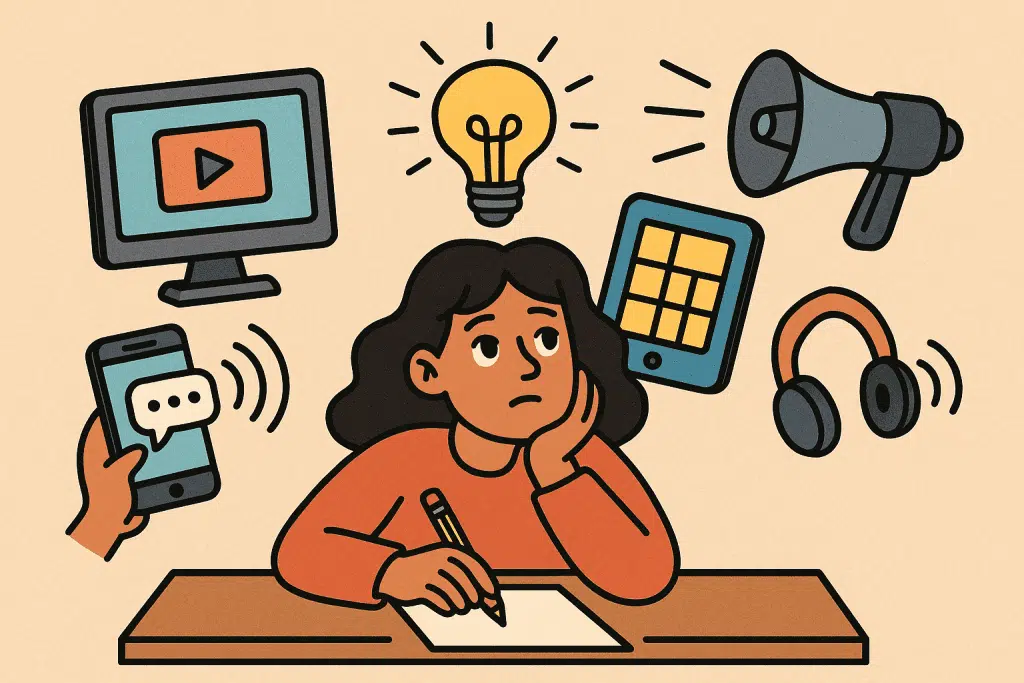How to Stay Creative in a World Full of Input
Isabella Lewis July 24, 2025
Staying creative in a world full of input is tougher than ever. Endless feeds, notifications, and content bombard your attention—so how do you protect your spark?

Why Creativity Suffers Amid Input Overload
The internet is both a blessing and a curse. While it offers endless inspiration, it also fragments focus and drains mental energy with constant notifications, emails, and content streams. This relentless influx makes it hard to maintain the mental clarity needed for creative thinking.
Cognitive overload happens when too much information overwhelms your working memory, impairing deep thinking and recall. The brain, unable to process everything, struggles to prioritize and connect ideas, which are crucial for creativity.
Reduced creativity stems from this overload. Studies show that excessive input stifles originality by crowding out the quiet mental space needed for reflection and novel ideas. The pressure to stay updated further limits time for creative exploration.
Continuous partial attention—constantly splitting focus across multiple sources—leads to fragmented thinking and mental fatigue. This state of distraction prevents deep engagement, eroding the ability to produce innovative work.
Understanding these challenges is the first step toward reclaiming your creative edge. Setting boundaries for digital consumption, practicing single-tasking, and carving out time for reflection can help restore focus and foster the conditions for creativity to thrive.
Trends & Tools: What’s Driving Change in 2025
- Calm Technology & Attention-Aware Design“Calm technology” prioritizes user focus with subtle, context-aware notifications and adaptive interfaces. In 2025, apps and devices use AI to detect focus levels, delivering alerts only when needed via gentle cues like haptics. This reduces digital overload, with wearables and smart homes blending seamlessly into daily life, enhancing productivity and well-being.
- AI-Augmented CreativityGenerative AI empowers creators by sparking ideas and automating repetitive tasks in art, writing, and design. The 2025 trend emphasizes balance—using AI to inspire without stifling originality. New tools promote “human-in-the-loop” workflows, ensuring creative control while addressing risks of homogenized outputs and ethical concerns around transparency.
- Structuring InspirationAI-driven “scaffolding creative ideation” organizes vast idea sets into actionable insights. In 2025, these tools analyze data, identify patterns, and create frameworks like mind maps, helping creators navigate inspiration with focus. This is transforming brainstorming, especially for teams, by streamlining collaboration and accelerating innovation.
These trends highlight a shift toward smarter, intentional technology that amplifies creativity and respects human attention in 2025.
Practical Guide: 8 Steps to Stay Creative
Build a Creative Ecosystem
Fuel your creativity by curating a lean, inspiring environment:
- Limit sources to 3–5 high-quality channels. Choose trusted outlets like a favorite blog, podcast, or magazine relevant to your craft. For example, a designer might follow a typography journal and a photography newsletter.
- Diversify perspectives. Mix industry news with unrelated fields, like a marketer exploring poetry or science journals to spark fresh ideas.
- Avoid echo chambers. Seek new voices by browsing independent blogs, attending talks outside your field, or visiting bookstores to discover unexpected perspectives.
Timeblock with Intent
Protect your creative focus by structuring your time:
- Use Pomodoro. Work in focused 25-minute bursts with 5-minute breaks to maintain energy. Apps like Forest can help.
- Separate input and output. Reserve mornings for inspiration (e.g., reading) and afternoons for creating (e.g., writing or designing) to avoid overwhelm.
Try Digital Detoxes
Unplug to clear mental clutter and boost creativity:
- Unplug daily or monthly. Take an hour offline each day or a full weekend monthly to let your mind wander. Try walks or journaling during these breaks.
- Limit distractions. Log out of social media or use “do not disturb” modes. Tools like Freedom can block distracting apps, freeing your mind for ideas.
Practice Mindfulness & Emotional Regulation
Stay mentally sharp with tools to manage stress and focus:
- Use mindfulness apps. Try a 10-minute meditation on Headspace to enhance focus before creative work.
- Quick emotional resets. Use the 5-4-3-2-1 breathing technique (inhale 5 seconds, hold 4, exhale 3, hold 2, repeat) to calm your mind and return to flow.
Use AI as a Creative Co‑pilot—Strategically
Leverage AI to spark ideas while keeping your unique voice:
- Prompt with purpose. Ask AI for specific brainstorming, like “10 metaphors for leadership inspired by nature,” to kickstart ideas.
- Add human insight. Refine AI outputs with personal experiences or emotions to ensure your work feels authentic, not generic.
Structure Your Stimuli
Organize inspiration to turn chaos into clarity:
- Use tools like Notion or Milanote. Tag ideas by theme (e.g., “quotes,” “visuals”) for easy access. A writer might save story prompts in a Notion database.
- Reflect weekly. Spend 30 minutes reviewing notes to connect ideas, asking, “How can these combine?” to spark breakthroughs.
Embrace Physical Separation
Create distraction-free spaces to focus:
- Set up a creative corner. Designate a clutter-free desk or coworking space for deep work, enhanced by small rituals like lighting a candle.
- Try tech-free days. Inspired by Sabbath traditions, spend a day monthly without devices, engaging in activities like reading or sketching to reset.
Invest in Brain Capital
Nurture your brain for sustained creativity:
- Prioritize health. Get 7–9 hours of sleep, eat brain-boosting foods like nuts, and exercise (e.g., a 20-minute walk) to enhance cognitive clarity.
- Take mental breaks. Engage in hobbies like gardening or playing music to recharge. Even brief naps can spark subconscious insights.
Real-world Workflow: A Sample Day
| Time | Activity |
|---|---|
| 7–8 AM | Exercise + mindful journaling |
| 8–9 AM | Check curated info feeds (max 3) |
| 9–12 PM | Deep creative work (no notifications + Pomodoro blocks) |
| 12–1 PM | Walk and digital detox |
| 1–3 PM | Idea-structuring session (tag and reflect) |
| 3–4 PM | Short AI brainstorm + iteration |
| 4–5 PM | Plan next day + light reading |
| Evenings | Tech-free time, hobbies, socializing |
Summary: Key Takeaways
- Staying creative in a world full of input means being both selective and strategic.
- Use calm tech, structured AI, mental habits, and physical boundaries to protect creativity.
- Treat your brain as valuable capital—invest in its long‑term strength.
Final Thoughts
You don’t have to drown in digital noise. By curating what you consume, applying clear boundaries, and leveraging emerging tools—like calm tech and creativity-supporting AI—you can carve out space for original thinking. Making creativity a daily habit will empower you to thrive, even when the input never stops.
References
Amabile, T. M. (1996). Creativity in Context: Update to the Social Psychology of Creativity. Westview Press. Retrieved from https://www.hbs.edu/faculty/
Runco, M. A., & Jaeger, G. J. (2012). “The Standard Definition of Creativity.” Creativity Research Journal, 24(1), 92–96. https://www.tandfonline.com/
Maddux, W. W., & Galinsky, A. D. (2009). “Cultural Borders and Mental Barriers: The Relationship Between Living Abroad and Creativity.” Journal of Personality and Social Psychology, 96(5), 1047–1061. https://psycnet.apa.org







